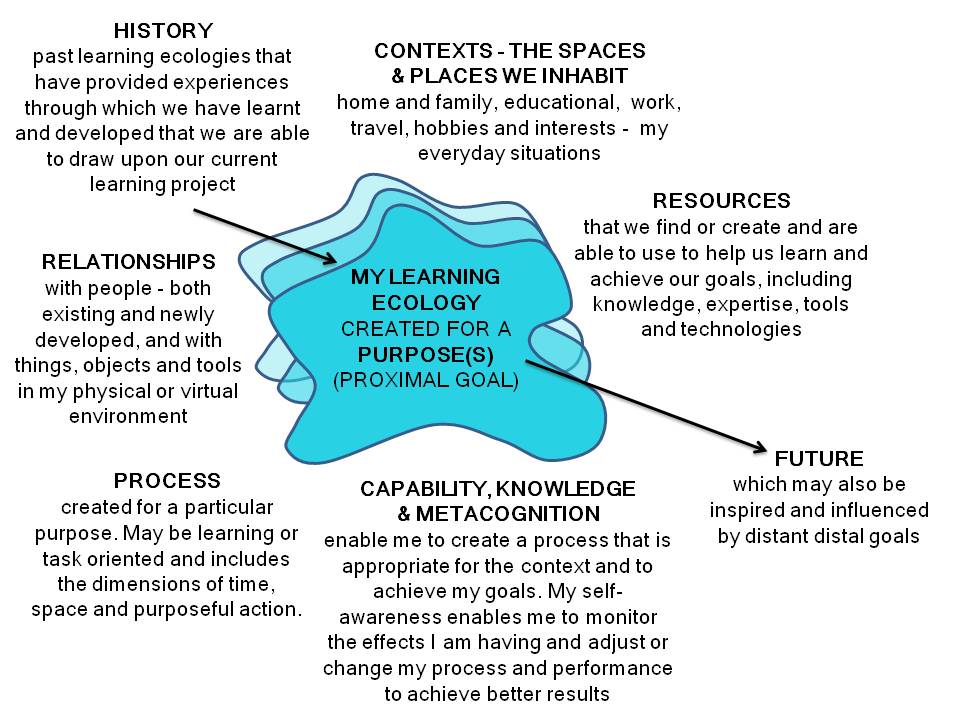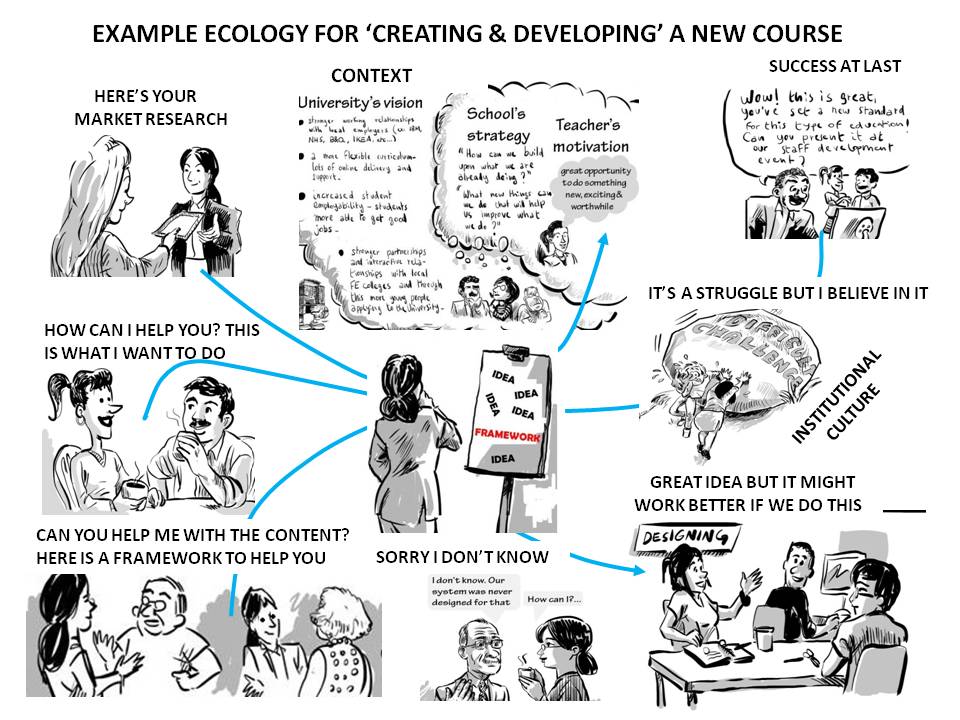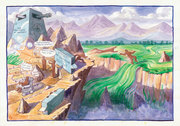
An individual's learning ecology comprises their processes and contexts, relationships, networks, interactions, tools, technologies and activities that provides them with opportunities and resources for learning, development and achievement. It's a holistic concept that connects the uniqueness of an individual through their purposes and actions to their environment. Such actions may be directed explicitly to learning but more likely they will primarily be concerned with achieving something like performing a task, solving a problem, or making the most of a new opportunity. Here is my synthesis representation.
The ecology we create to develop something, like for example a new educational course, is the living vehicle for our creativity. The evolving ecology is itself an act of creation which can be defined using Rogers (1961) concept of creativity. It is our self-determined and self-expressed process for achieving tangible proximal goals, within which we create our novel relational products [including our own development] grown out of our individual uniqueness which has been shaped by our past histories and imaginings of a different and better future, and the materials, events, people and circumstances of our life.
Learning Ecology Narratives
We can give meaning and substance to the concept of a learning ecology by creating a narrative of a developmental process (what we did and why we did it, when and where and how we did it, who we did it with and what new learning and things emerged through our actions and activities). In this example a university lecturer and an e-learning advisor describes an ecology they created to bring into existence a number of e-learning modules for professionals in the fashion industry. This type of ecology is typical for anyone trying to innovate within a university.
Example learning ecology revealing how an individual with the help of others created new e-learning modules in a School of fashion based on a transcript of an interview(5) Creativity is the 'the emergence in action of a novel relational product growing out of the uniqueness of the individual on the one hand, and the materials, events, people, or circumstances of his life'
Linda: A teacher's perspective on development
I obviously used the [market] research that we had done. Discussed with the head of school and the other school management what the outcomes of this research were and the headings that we would put together to begin to develop the short courses. Then I had to find external people to help with writing content. Obviously I had to start somewhere. My strongest feeling was that I needed to provide a framework for the people to work with. So I began to think about that before getting anyone external involved. I worked with John in the e-Development Centre quite extensively on trying to develop this effective way of delivering taught modules online and trying to put together a framework for the externals to use when putting together their teaching material. Basically I wrote most of the unit descriptors, the sort of bible for how these would be developed in terms of teaching material and then provided that usually to the external member of staff. I found these people [using] my own contacts and appealing to people’s better nature because I think the payment that they were receiving wasn’t necessarily equivalent to freelance pay that they would normally... But I worked very closely with them. They came into the university at certain strategic times throughout the development and a lot of email communication took place with them sending me materials and me checking it and going back to them with feedback. Really, really resource heavy actually. Really time consuming for me in terms of head space and having to pull myself out of my daily operation, job, my normal responsibilities and doing this on top of that.
I was getting six hours relief from my normal duties six hours doesn’t reflect in any way, shape or form the amount of time that I put into developing these twelve short courses that were to be accredited by the university all at once with externals helping for some of them and not for others. I was doing a considerable amount of reading through materials and feeding back during my own time in the evenings and weekends. Without that, it would not have happened. But I felt very, very strongly at the time that these are winners. There is a market for them and if we can market them in the right way I always felt they would be successful. I believed in the framework that I developed and that it was an effective, clear and understandable way to go through a short course for anyone who is working and [wants learning] that is relevant to their industry.
[it felt like] a constant battle because I always felt as though I was having to push other departments and other areas of the university to give me answers to questions that I had. It always felt as though the answers didn’t exist in that point in time, but I needed them. I needed to know answers to certain questions and I needed sometimes some kind of framework for me to be working within and none existed. I obviously eventually got a hold of the guidelines for developing professional development units from our quality department, but I had no knowledge of that prior to poking and pushing and constantly asking for that information. I was actually quite aggrieved at the time that that existed and I hadn’t been alerted to the fact that that existed before I began to develop the courses, because surely that would have helped. Some staff development for me would have been highly appreciated.
Once I had actually got past that initial stage of how do I put these first drafts of the units together, things began to roll and I began to discover who I could at least go and say ‘Look I have t[his question, who can I ask? Who is going to answer it for me? I need answers.’ I think I probably began perhaps to become a little bit annoying for some people because I kept saying ‘I need an answer’ and ‘I need to know.’
Some of the most difficult issues, I would say, were managing the externals because some of them didn’t have a huge experience of teaching.....it was very difficult to find people that could actually do this with me. I chose them based on their expertise, in the areas that I wanted the content developed around. So I was having to sort of almost coach them in learning and teaching as we were going as well, plus trying to help them understand how their material was going to be used online and the amount of discussion on text that was required of them rather than just bullet point teaching. So that was another challenge that came later.
I was having to be a subject person - most of these are in an area that I can apply my expertise to. I was having to be a learning and teaching person and an online education person, working with John . Initially it was a couple of conversations that I was going to be doing this and understanding that a really clear framework would need to be put in place and how online teaching and learning would be different to in-class teaching and learning. Them, I guess, explaining to me the most important aspects to consider. Then I gradually spent more and more time with the people from EDC, particularly John, and asked for their feedback on what I was developing and what the externals were developing with me. They got more and more involved in it because they really believed in what I was doing once the momentum got going. They sort of started to understand what I was trying to achieve from my perspective and then they saw the potential in that and gave me more and more time. Their time was then really important to the success of the project because without them helping me so much, I wouldn’t have achieved the outcomes. Basically I felt like I had made some friends there and they were going to help me get through this if no one else was. So they were incredibly supportive. It wasn’t uncommon for John and I to both be online at 11 o’clock at night talking back and forth and looking at the units online and discussing areas of the unit that were strong or not so strong, that needed a bit of work, a bit of development, changing things, ‘What do you think of this?’ It wasn’t uncommon for us to be doing that in the evenings because of our own personal motivations.
It was a huge learning curve for me and because at certain times I was quite vocal about the fact that I wasn’t getting answers and I was quite persistent and tenacious about sorting things out and getting through this project. I was just tenacious in the fact that I will get this done and I will find the help somewhere and someone will give me the answers I need because I have to do this... and there were I think two occasions when… and I am being really honest now. Two times in the year when I said ‘I have had enough. No one else is as driven as I am about developing these PDUs so I give up.’ You know, those moments of kind of this is just so frustrating and no one else seems to be as bothered as I am so why am I doing it. You know? Actually this is only my own personal motivation that is making this happen, so why am I so worried? But the next day was a new day and I continued to work on it because I know I am not really going to give up on doing this. I was venting frustrations and trying to I guess not get attention but get people to respond to me and find a way through. But yeah, there were two occasions at which I got to that point.
John: An instructional developer's perspective on development
I worked with a number of academics to help them develop their on-line courses targeted at the professional market - the concept is for entirely distance and entirely online professional development units, short 12 week credit bearing units. One of the people I worked with was Linda in the Fashion Department. She had a fairly good idea of how she wanted to structure the units in terms of how the content would be delivered and also in terms of some of the learning activities that the students would participate in. Where I came in was then to look at how that actually translates into online content, how you get it online, how you guide the students through the materials, how you make it accessible, how you stage and present particular events. Because on-line units have events such as web conferences that happen two or three times during the duration of the twelve weeks, and there’s points at which where the students are asked to then communicate with a peer partner and they might have a one-to-one tutorial with their tutor.
So I went into discussions with Linda particularly at first over the unit that she wrote herself. She was at the forefront of this area of development - the first person to actually get a unit developed. I looked at what originally was a Word document map of how she wanted the activities to occur, and sat down and discussed with her how that might best or better be structured in terms of the activity points that happen throughout it, where you might place the assessment tasks, like the formative and final assessment tasks. And then, because what we’d worked on as a team was getting a look and feel and format for how the content goes online, I worked with her Word document plans and putting that up online, putting the content in the correct places. Together we created the detailed design and content Linda typing directly the stuff online or I took ideas of hers and put it up for her, putting the online tools into the correct place. And between us, moving things within her unit until it felt like there was a structure that would actually guide the students through structured study. And the work on Linda's unit kept going on for a long time because that was the one we were really trying to refine down as an exemplar. So it was a highly co-creative process and the work we did then helped us to establish a template and a guide for how other PDUs could be developed and written ...which has proved very useful [for the university].
These narratives reveal the wonderfully interwoven productive relationships that can be developed between an educational developer with an institutional remit for helping academic teaching staff, and a lecturer who would like to innovate using technology and a learning environment that was initially unfamiliar to her. Effectively, the instructional developer is helping the lecturer to adapt to an entirely new teaching and learning context. By combining their expertise and passions both participants are able to contribute ideas, knowledge and expertise to the process that leads to the development of new on-line courses and the 'know how' and guidance to help other academics who want to develop similar on-line professional development courses. But the relationships do more than enabling people to share and combine their ideas and expertise - they stimulate new ideas, help sustain motivations and provide emotional support at difficult times. Relationships were clearly an important part of the ecology for development some of which enabled some of which hindered or mediated the innovation - but all had to be accommodated and worked with. Relationships included people with knowledge and expertise (essential resources) in the design of on-line educational courses and learning environments, experts in the teachers professional network who would provide the content for the on-line courses and people in central roles in quality assurance whose systems and procedures had to be satisfied. The narrative reveals something of the dynamic, messyness and emotion of the development process, and the organisational culture within which it unfolded. It will resonate with anyone who has to tried to engage in significant development in a university. But these stories also reveal the wonderful effects of creative collaboration by people who believe, trust, respect and understand each other. Linda is clear that her creativity played an important role in this educational development work.
Linda: I think due to the fact that I was doing something new allowed a level of creativity yes, I think when you are developing any aspect of the curriculum you are being 'creative', you have the feeling that you have the opportunity to 'shape' what is available for people/students to learn and you are 'creating' that learning experience. I personally find that a creative process. It isn't entirely without edges though, there are boundaries and quality considerations to work within but still, there is room within the set frameworks to 'create' the richness of content and the teaching and learning strategies that encourage an inspirational learning process. I am a 'creative' at heart and maybe that is something else that is a driver for me when doing the types of projects that I involve myself in.
Why not join our Creativity in Development Project http://www.creativityindevelopment.co.uk/
Information sources
1. Jackson, N. J. (2013a) The Concept of Learning Ecologies, in N. J. Jackson and G.B. Cooper (eds) Lifewide Learning, Education and Personal Development E-book Chapter A5 available on-line at http://www.lifewideebook.co.uk/conceptual.html
2. Jackson, N. J. (2013b) Learning Ecology Narratives, in N. J. Jackson and G. B. Cooper (eds) Lifewide Learning, Education and Personal Development E-book Chapter C4 available on line at: http://www.lifewideebook.co.uk/research.html
3. Jackson, N.J. (2014) Lifewide Learning and Education in Universities & Colleges: Concepts and Conceptual Aids in N Jackson and J Willis (eds) Lifewide Learning and Education in Universities and Colleges Chapter 1 available at:
http://www.learninglives.co.uk/e-book.html
4. Rogers, C.R., (1961) On becoming a person. Boston: Houghton Mifflin
5. Baker, P., Jackson, N.J. and Longmore, J. (2014) Tackling the wicked challenge of strategic change: The story of how a university changed itself Authorhouse





 RSS Feed
RSS Feed